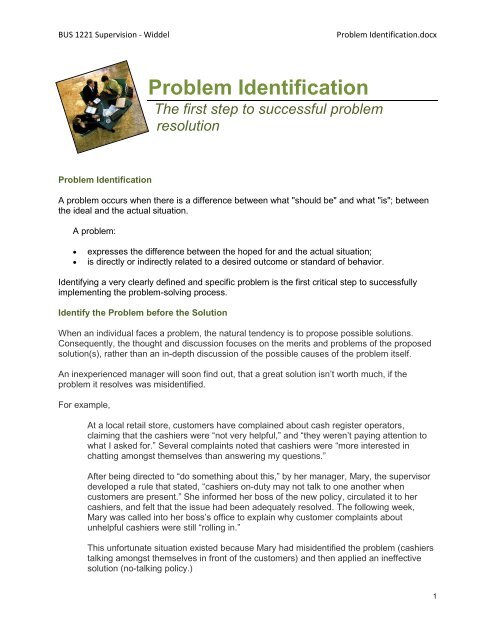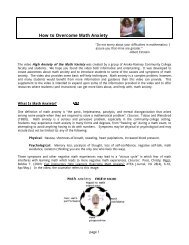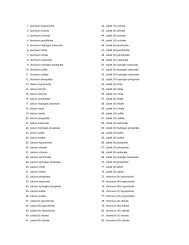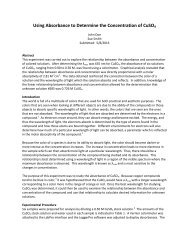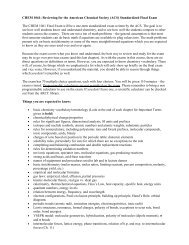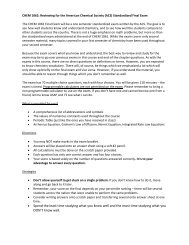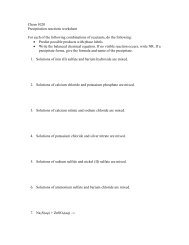Problem Identification
Problem Identification
Problem Identification
Create successful ePaper yourself
Turn your PDF publications into a flip-book with our unique Google optimized e-Paper software.
BUS 1221 Supervision - Widdel<strong>Problem</strong> <strong>Identification</strong>.docx<strong>Problem</strong> <strong>Identification</strong>The first step to successful problemresolution<strong>Problem</strong> <strong>Identification</strong>A problem occurs when there is a difference between what "should be" and what "is"; betweenthe ideal and the actual situation.A problem:expresses the difference between the hoped for and the actual situation;is directly or indirectly related to a desired outcome or standard of behavior.Identifying a very clearly defined and specific problem is the first critical step to successfullyimplementing the problem-solving process.Identify the <strong>Problem</strong> before the SolutionWhen an individual faces a problem, the natural tendency is to propose possible solutions.Consequently, the thought and discussion focuses on the merits and problems of the proposedsolution(s), rather than an in-depth discussion of the possible causes of the problem itself.An inexperienced manager will soon find out, that a great solution isn’t worth much, if theproblem it resolves was misidentified.For example,At a local retail store, customers have complained about cash register operators,claiming that the cashiers were “not very helpful,” and “they weren’t paying attention towhat I asked for.” Several complaints noted that cashiers were “more interested inchatting amongst themselves than answering my questions.”After being directed to “do something about this,” by her manager, Mary, the supervisordeveloped a rule that stated, “cashiers on-duty may not talk to one another whencustomers are present.” She informed her boss of the new policy, circulated it to hercashiers, and felt that the issue had been adequately resolved. The following week,Mary was called into her boss’s office to explain why customer complaints aboutunhelpful cashiers were still “rolling in.”This unfortunate situation existed because Mary had misidentified the problem (cashierstalking amongst themselves in front of the customers) and then applied an ineffectivesolution (no-talking policy.)1
BUS 1221 Supervision - Widdel<strong>Problem</strong> <strong>Identification</strong>.docxIf the supervisor had done some additional exploration regarding the problem and asked thequestion, “why are the cashiers perceived as unhelpful and chatting amongst themselves ratherthan helping the customer?” her research would have determined that the cashiers had notbeen adequately trained in customer service standards and expectations. They weren’t aware ofhow they should greet the customers or how they should deal with customer requests.If the supervisor had correctly identified the problem – a lack of customer service training for thecashiers was resulting in poor customer service at the point of check-out, she would haveimplemented a different (and more appropriate) solution.Identify the <strong>Problem</strong>, not a SymptomIf you want to resolve the root problem, treat the cause, not the symptom. For example, if youtake an aspirin for a fever, you’re treating the symptom (an elevated temperature) and nottreating the cause. You might experience temporary relief, but if the cause is left untreated, it’slikely that the fever will return.The same is true for resolving work-related problems. For example…Mary was told to deal with the problem of her cashiers receiving customer complaints(the symptom) so she instituted a new policy that said, “if an employee receives three ormore customer complaints over a single pay period, (s)he will be fired.”This no-talk policy may certainly produce short-term benefits, but if the supervisor neveridentifies the lack of effective training as the real problem, then the customer complaints aresure to continue. Firing the offending cashiers (an outcome of the new policy that treats asymptom) will not resolve the issue if the replacement hires don’t receive adequate training (anecessary treatment for the root problem).Sometimes numerous negative symptoms are all outcomes of a single root problem – so solvingthe root problem will resolve many related problems.Ask “Why?, Why?, Why?, Why?”Identifying a root problem may require the supervisor to ask several “whys?” For example..Why are customers complaining about the cashiers?Because the cashiers are not paying adequate attention to their needs during the checkout.Why are cashiers not paying adequate attention to customer needs during the check-out?Because they are unaware that their behavior is off-putting to the customer.Why are the cashiers unaware that their behavior is not acceptable to customers?1) Because they are not aware of what specific customer service behaviors areexpected of them in this position.2
BUS 1221 Supervision - Widdel<strong>Problem</strong> <strong>Identification</strong>.docx2) Their lack of appropriate behavior was never identified and flagged asunacceptable by a supervisor.Why are the cashiers unaware of the expected behaviors of their job?1) Because they did not receive enough training about necessary behaviors, onlyabout computer operation, bagging and money handling.2) Because the supervisor didn’t perform an adequate performance appraisal in thefirst two weeks of their job.Notice in this example that two causes of the poor customer service surfaced. If the supervisorhad not asked “why” then she would probably not have identified her role in creating thisproblem.When you’ve done a good job of correctly identifying the root problem(s) then the task ofidentifying workable solutions is much easier.State a <strong>Problem</strong> Concisely and PreciselySometimes the identification of a problem gets lost in translation. A well-stated problem is onethat can be stated in a single sentence.For example, in the case of the chatty cashiers, the problem could be stated as “a lack ofeffective customer service training for cashiers is resulting in too many incidents of dissatisfiedcustomers.”Notice that this problem statement doesn’t focus on a solution – it focuses on the root cause ofthe undesired outcome, customer dissatisfaction. It also summarizes the problem into asingle sentence that contains the cause (lack of effective customer service training) aswell as the effect (too many instances of dissatisfied customers).A statement that is written as, “the problem is that the cashiers need training” is not correctlyphrased as a problem, it is phrased as solution.The Acid TestOne test for checking to see if the problem you’ve identified is the real problem, is to ask thequestion, “if the problem I’ve stated had been resolved from the very beginning, would thiscurrent situation be happening?”Applying this test to the previous example…If the supervisor had first asked, “if the cashiers didn’t talk to one another, would thecustomers be complaining?” she could have quickly determined that her solution ofimplementing a don’t-talk policy wouldn’t resolve the larger issue of cashiers’ lack ofhelpfulness. She should have been able to foresee the failure of a no-talk policy becauseit didn’t resolve the unhelpfulness problem due to a lack of training.3


